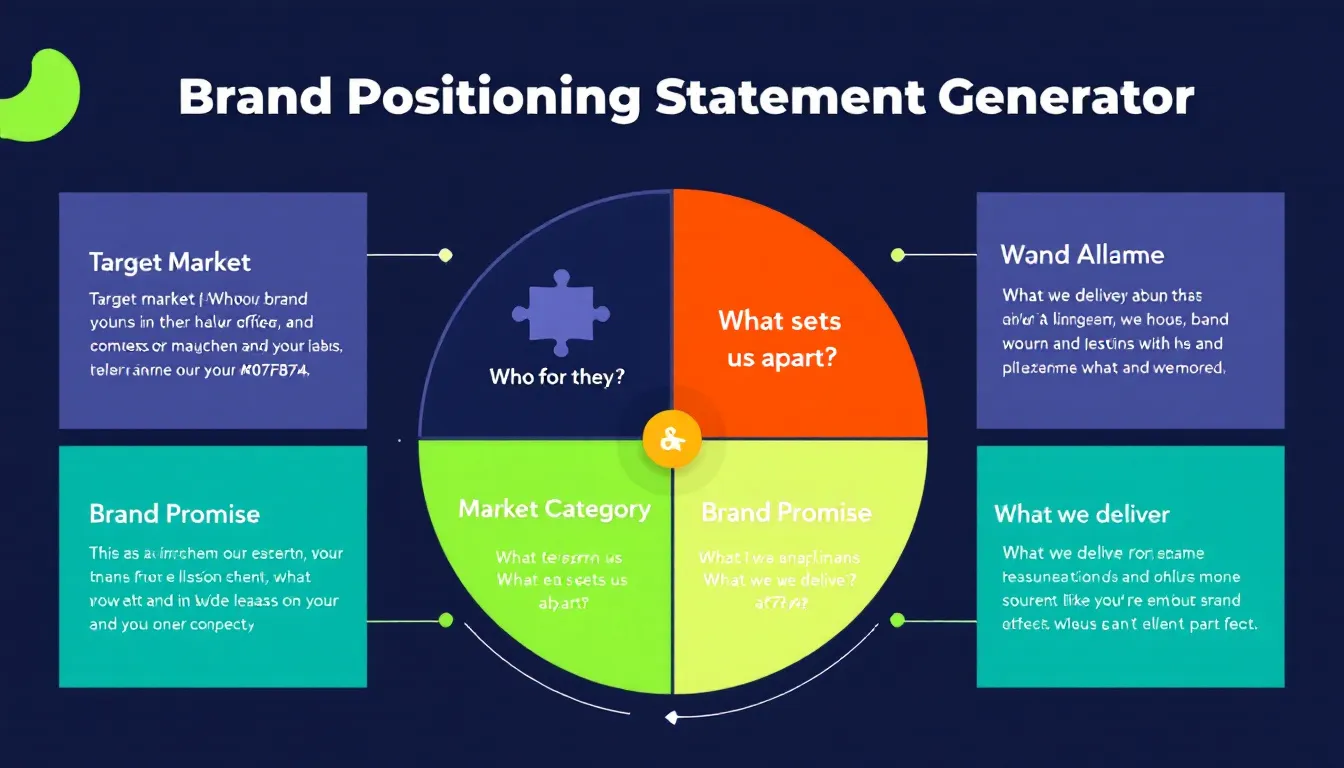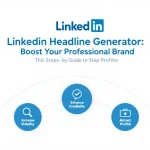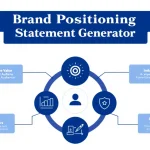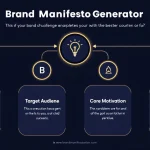Is this tool helpful?
How to Use the Brand Positioning Statement Generator Effectively
Use this brand positioning statement generator to craft clear and impactful statements by completing the following fields precisely. This will help you communicate your brand’s unique place in the market.
- Enter your brand name to identify your business or product clearly (e.g., “EcoWave Electronics” or “PurePath Supplements”).
- Describe your unique value proposition by explaining what sets your brand apart from competitors (e.g., “Affordable smart home devices with energy-saving features” or “All-natural supplements designed for enhanced immunity”).
- Specify the problem or need your brand addresses, focusing on the key issue you solve (e.g., “High energy costs and lack of home automation” or “Limited access to effective natural immunity boosters”).
- Define your target audience with specific characteristics to focus your marketing efforts (e.g., “Tech-savvy homeowners aged 30-50 focused on sustainability” or “Health-conscious adults seeking holistic wellness solutions”).
- Optionally, include your industry sector for more targeted positioning (e.g., “Consumer Electronics” or “Health & Wellness”).
Field-by-Field Explanation
Brand Name
Input the brand name exactly as it should appear in your positioning statement. This ensures clear brand recognition.
- BrightNest Gardening
- QuantumSync Software
Unique Value Proposition
Explain what uniquely sets your brand apart. Use simple, descriptive language to highlight your key strengths.
- Eco-friendly packaging solutions with biodegradable materials
- Cloud-based project management tools with real-time collaboration
Problem or Need Addressed
Describe the main problem or need your brand solves for your customers.
- Growing waste from single-use plastics impacting urban environments
- Inefficient communication slowing down remote team productivity
Target Audience
Be specific about who your ideal customers are, including demographic and psychographic details.
- Environmentally aware consumers aged 20-35 focused on reducing plastic waste
- Remote project managers and freelancers looking for seamless task management
Industry (Optional)
Optionally, specify your industry to help tailor the statement toward your sector.
Introduction to the Brand Positioning Statement Generator
This brand positioning statement generator helps you develop a focused, compelling brand statement that highlights your unique value, target market, and the key problem you solve. A well-crafted positioning statement guides marketing strategies and aligns your team around a clear market position.
By entering precise details about your brand, audience, and industry, you get a structured statement that saves time, sharpens your messaging, and improves internal clarity. Use the generator to ensure your brand communicates consistently across all channels and stands out from competitors.
Practical Uses of the Brand Positioning Statement Generator
Startup Brand Development
Startups can quickly define their market position and value by plugging in clear inputs. For example:
- Brand Name: SolarBright Technologies
- Unique Value: Affordable, high-efficiency solar panels with easy installation
- Problem Solved: Expensive and complex solar power setups limiting adoption
- Target Audience: Homeowners aged 30-60 interested in renewable energy solutions
- Industry: Renewable Energy
Brand Repositioning and Expansion
Existing brands can refine or shift their positioning to enter new markets. For example:
- Brand Name: Urban Roots Coffee
- Unique Value: Specialty coffee blends sourced from small-scale farmers with direct trade
- Problem Solved: Lack of traceability and fair trade practices in coffee supply chains
- Target Audience: Coffee aficionados who support ethical and sustainable sourcing
- Industry: Specialty Food & Beverage
Understanding the Components of an Effective Brand Positioning Statement
- Target Market Definition: Identifies exactly who your brand serves
- Market Category: Defines your industry or competitive frame
- Brand Promise: States your key value or benefit for customers
- Reason to Believe: Offers evidence or proof to support your claims
Maximize Your Brand Statement’s Effectiveness
Best Practices
- Keep your statement concise and clear
- Use specific, measurable benefits and claims
- Highlight what truly sets you apart from competitors
- Make sure your claims are credible and backed by evidence
- Align your message with current market trends and conditions
Common Mistakes to Avoid
- Using broad or vague target audience descriptions
- Including generic or unsubstantiated value propositions
- Copying competitors’ positioning without adaptation
- Ignoring shifts in market dynamics or customer needs
Frequently Asked Questions About Brand Positioning Statements
What is a brand positioning statement?
It’s a clear, concise summary that defines your brand’s unique place in the market by pinpointing your audience, unique benefits, and competitive advantage.
How often should I update my brand positioning statement?
Review it yearly or whenever significant market shifts or changes in consumer behavior happen to keep your messaging relevant.
Should my company mission be part of the positioning statement?
No. Your mission and positioning serve different purposes. The positioning statement focuses on market placement and unique benefits, while your mission explains your company’s broader purpose.
Can I create multiple positioning statements?
Yes, customize statements for different markets or segments while maintaining your core brand identity for consistency.
How do I validate my positioning statement?
Test it with customers, industry professionals, and team members to ensure it resonates and accurately reflects your brand.
Is a brand positioning statement public-facing?
Usually, it stays internal to guide marketing and brand decisions, although it informs your public messaging indirectly.
How detailed should my target audience description be?
Include specific demographics, behaviors, and psychographics that define your ideal customer while keeping it focused and actionable.
Important Disclaimer
The calculations, results, and content provided by our tools are not guaranteed to be accurate, complete, or reliable. Users are responsible for verifying and interpreting the results. Our content and tools may contain errors, biases, or inconsistencies. Do not enter personal data, sensitive information, or personally identifiable information in our web forms or tools. Such data entry violates our terms of service and may result in unauthorized disclosure to third parties. We reserve the right to save inputs and outputs from our tools for the purposes of error debugging, bias identification, and performance improvement. External companies providing AI models used in our tools may also save and process data in accordance with their own policies. By using our tools, you consent to this data collection and processing. We reserve the right to limit the usage of our tools based on current usability factors.







